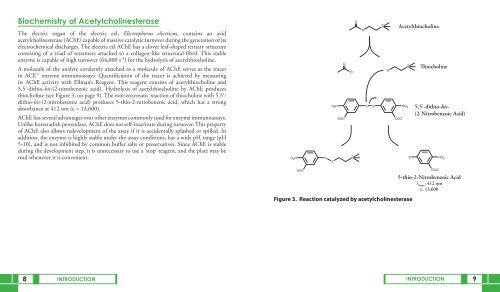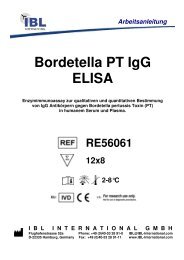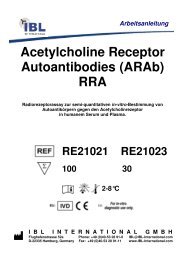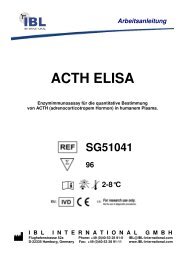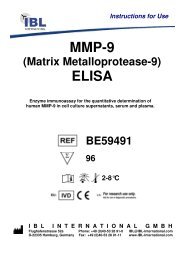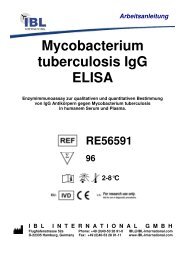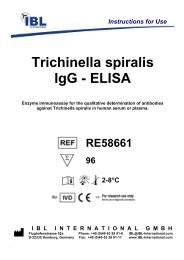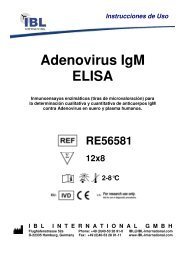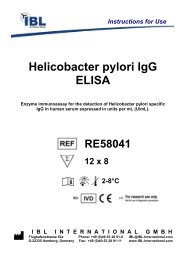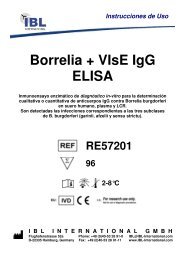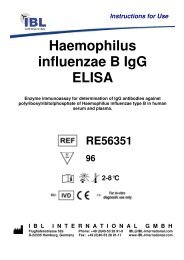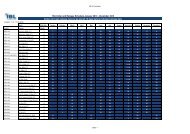Prostaglandin E2 Metabolite ELISA - IBL International
Prostaglandin E2 Metabolite ELISA - IBL International
Prostaglandin E2 Metabolite ELISA - IBL International
You also want an ePaper? Increase the reach of your titles
YUMPU automatically turns print PDFs into web optimized ePapers that Google loves.
Biochemistry of Acetylcholinesterase<br />
The electric organ of the electric eel, Electrophorus electricus, contains an avid<br />
acetylcholinesterase (AChE) capable of massive catalytic turnover during the generation of its<br />
electrochemical discharges. The electric eel AChE has a clover leaf-shaped tertiary structure<br />
consisting of a triad of tetramers attached to a collagen-like structural fibril. This stable<br />
enzyme is capable of high turnover (64,000 s -1 ) for the hydrolysis of acetylthiocholine.<br />
A molecule of the analyte covalently attached to a molecule of AChE serves as the tracer<br />
in ACE enzyme immunoassays. Quantification of the tracer is achieved by measuring<br />
its AChE activity with Ellman’s Reagent. This reagent consists of acetylthiocholine and<br />
5,5’-dithio-bis-(2-nitrobenzoic acid). Hydrolysis of acetylthiocholine by AChE produces<br />
thiocholine (see Figure 3, on page 9). The non-enzymatic reaction of thiocholine with 5,5’dithio-bis-(2-nitrobenzoic<br />
acid) produces 5-thio-2-nitrobenzoic acid, which has a strong<br />
absorbance at 412 nm (ε = 13,600).<br />
AChE has several advantages over other enzymes commonly used for enzyme immunoassays.<br />
Unlike horseradish peroxidase, AChE does not self-inactivate during turnover. This property<br />
of AChE also allows redevelopment of the assay if it is accidentally splashed or spilled. In<br />
addition, the enzyme is highly stable under the assay conditions, has a wide pH range (pH<br />
5-10), and is not inhibited by common buffer salts or preservatives. Since AChE is stable<br />
during the development step, it is unnecessary to use a ‘stop’ reagent, and the plate may be<br />
read whenever it is convenient.<br />
8 INTRODUCTION INTRODUCTION 9<br />
O 2 N<br />
- OOC<br />
S<br />
O 2 N<br />
S<br />
O<br />
- OOC<br />
O -<br />
N +<br />
O<br />
S<br />
N +<br />
- S<br />
S S NO 2<br />
Acetylthiocholine<br />
COO -<br />
Figure 3. Reaction catalyzed by acetylcholinesterase<br />
N + �iocholine<br />
- S<br />
5,5'-dithio-bis-<br />
(2-Nitrobenzoic Acid)<br />
COO -<br />
NO 2<br />
5-thio-2-Nitrobenzoic Acid<br />
λ max : 412 nm<br />
ε: 13,600


